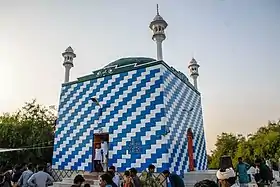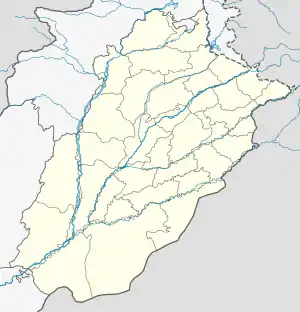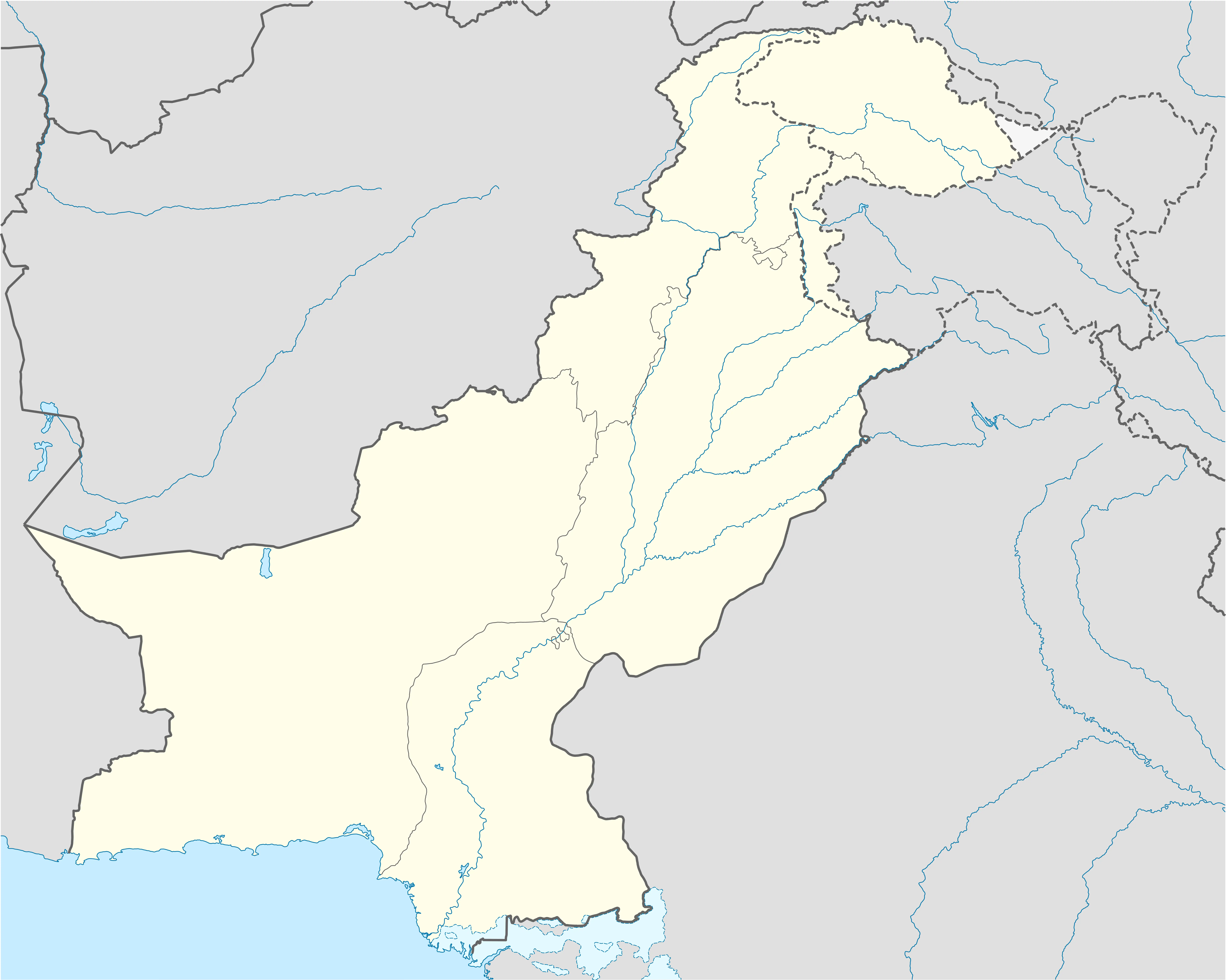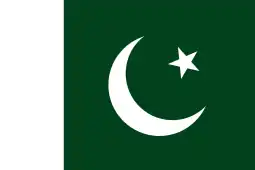Jhang
Jhang (جھنگ; Punjabi pronunciation: [ˈt͡ʃə̀ŋ.gᵊ]; Urdu pronunciation: [d͡ʒʱəŋɡ]) is the capital city of Jhang District, in the central portion of the province of Punjab, Pakistan. Situated on the east bank of the Chenab river, it is the 18th largest city of Pakistan by population.[2]
Jhang
جھنگ | |
|---|---|
     Clockwise from top: Shrine (Darbar) of Pir Abdul Rehman Shrine (Darbar) of Heer Ranjha Darbar Shrine (Darbar) of Sultan Bahoo, a Sufi saint, Chenab College, Trimmu Barrage, Chenab Bridge | |
 Jhang Location of Jhang in Pakistan  Jhang Jhang (Pakistan) | |
| Coordinates: 31°16′10″N 72°18′58″E | |
| Country | Pakistan |
| Province | Punjab |
| Division | Faisalabad |
| District | Jhang |
| Area | |
| • Total | 28.27 km2 (10.92 sq mi) |
| Population | |
| • Total | 414,131 |
| • Rank | 16th, Pakistan |
| • Density | 15,000/km2 (38,000/sq mi) |
| Time zone | UTC+5 (PST) |
| Postal code | 35200 |
| Calling code | 047 |
The historical name of the city and district is Jhang Sial.[3][4][5]
The locality also includes the Shrine (Darbar) of Pir Abdul Rehman hrine of Sultan Bahu and Heer and Ranjha's Tomb.
Etymology
The historical name of the city and district is Jhang Sial.[3] The word Jhang is derived from the Sanskrit word jāṅgala which means rough or forested terrain, the word Jungle also sharing the same root. In context, the term Jhang was derived from the Sanskrit word jāṅgala, Jhang Sial being the historic name of the locality, literally translating into ‘The terrain of the Sials’.[3][4][6]
History

Ancient
The Ancient Greek army led by Alexander the Great encamped here in Jhang and stayed some time to make preparation to proceed ahead, several local tribes like Vains, Longs, Nauls and Noons are allegedly described to be the descendants of Alexander's army men.
Islamic conquest
Muhammad bin Qasim conquered the nearby city of Multan, so area of Jhang came under Arabs for a few centuries. Then town of Jhang became part of Multan province of Mamluks ruled by different rulers.[5]
The asta town was ory of Jhang is the history of the Sial tribe.[3]
Jhang was built in 1288 by Maharaja Rai Sial, a Rajput chief and founder of the Sial Tribe.[6]
The Sial tribe, his kin, ruled this district ever since until the last Sial ruler of Jhang, Ahmad Khan (1812 to 1822) was defeated by Ranjit Singh after fierce fighting.[3][7]
Under the collective rule of the Sial Khans of Jhang and other Sial sub-tribes such as the Rajbana and Bharwana, in the zenith of their power, the Sial country of Jhang extended up to the Muzafargarh boundary in the south, and the entirety of Chiniot, Kamalia and Kabirwala ilakas. The territory extended to parts of Bhakkar and Sargodha. The Garh Mahraja and Ahmadpur Sial ilakas were added to the possessions of the Rajbana Sial tribe who drove out the Baloch tribes to the Thal and defeated the Nawab of Multan by the mid 17th century.[3][4]
Under the British Raj, the towns of Jhang and Mighiana, lying two miles (3.2 km) apart, became a joint municipality, then known as Jhang-Maghiana.[8]
Maghiana lies on the edge of the highlands, overlooking the alluvial valley of the Chenab, while the older town of Jhang occupies the lowlands at its foot.[8]
Geography
Jhang is situated at the East bank of Chenab which has confluence with Jhelum at Trimmu Barrage near the town of Athara Hazari. The city was endangered in the 2014 floods but it was not flooded as the flood water was redirected towards Athara Hazari.[9] there are three river in jhang such as chenab river jhelum river and river ravi is also touch with the boundary of District Jhang near Ahmadpur Sial.
Demographics
The population of city in 1998 Census of Pakistan was recorded as 293,366. According to the 2017 Census of Pakistan, the population of city rose to 414,131 with a growth of 41.17% in 19 years.[1]
Administration
Jhang Saddar is the administrative center of Jhang Tehsil (a subdivision of the district). The tehsil itself is divided into 55 Union councils.[10]
Education
- Virtual University of Pakistan (Jhang Campus)
- Lahore College for Women University (Jhang Campus)
- University of Veterinary and Animal Sciences (Jhang Campus)
- Government Post Graduate College
- Chenab College Jhang
- University of Jhang
- Punjab Group of Colleges
- Superior Group of Colleges
- Dar-e-Arqam Schools
- Cambridge Grammar School
- Beaconhouse School System
- The City School
Notable people
Scientists
- Abdus Salam, first Pakistani Nobel Laureate (Physics).
- Yash Pal, Indian scientist.
- Har Gobind Khorana, Indian American biochemist
Politicians
- Khan Muhammad Arif Khan Rajbana Sial, former federal and provincial minister, honourable Chief Whip of All-India Muslim League, close associate of the Quaid-e-Azam and key figure in the Independence Movement of Pakistan.
- Syeda Abida Hussain, former Pakistani Ambassador to USA and federal minister.
- Makhdoom Faisal Saleh Hayat, former Interior Minister of Pakistan and FIFA official.
- Sahibzada Nazir Sultan, former Member National Assembly.
- Sahibzada Mahboob Sultan, federal minister.
- Ghulam Bibi Bharwana, Member National Assembly.
- Najaf Abbas Sial, former Member National Assembly and Member Provincial Assembly.
- Sheikh Waqas Akram, former minister of state for Labour and Manpower
- Haq Nawaz Jhangvi, Pakistani cleric, founder of Sipah-e-Sahaba Pakistan and namesake of Lashkar-e-Jhangvi
- Masroor Nawaz Jhangvi, Pakistani Islamic cleric and politician, Member of Provincial Assembly (MPA) Punjab, son of Haq Nawaz Jhangvi
Sports personalities
- Aleem Dar, cricketer and umpire
- Ghulam Shabber, UAE cricket player
Literary personalities
- Majeed Amjad, Urdu poet
- Nasir Abbas Nayyar, Pakistani Urdu language columnist
- Ishtiaq Ahmad (fiction writer)
Pirs/religious figures
- Sultan Bahu, founder of the Sarwari Qadiri Sufi order
- Shah Jeewna, Sufi saint, founder of Qalandariyya order
Business people
- Sheikh Waqas Akram, founder of Shalimar Transport
Geographic location
Jhang Sadr is a city in Punjab, Pakistan. It is located at 31.27 latitude and 72.33 longitude and it is situated at an elevation of 158 meters above sea level.
References
- "Pakistan: Provinces and Major Cities - population of Jhang city per 2017 census". Citypopulation.de website. Archived from the original on 29 June 2020. Retrieved 22 May 2023.
- "Pakistan City & Town Population List". Tageo.com website. Retrieved 22 May 2023.
- Punjab Government (1883). Gazetteer Of The Jhang District. pp. Chap. II. — History. 27.
- "Gazetteer - Punjab District Gazetteers, Jhang District, with Map, 1929 - South Asia Archive". www.southasiaarchive.com. Retrieved 22 September 2020.
- "HISTORY OF JHANG". Jhang on Punjab Portal, Government of Pakistan website. Retrieved 22 May 2023.
- Wikeley, J. M. Punjabi Musalmans. Robarts - University of Toronto. Lahore Book House.
- "Government of Pakistan, Map of Jhang" (PDF).
- Jhang District article in the Imperial Gazetteer of India, v. 14, pp. 125 - 134
- Shamsul Islam (10 September 2014). "Panicked residents flee Jhang city". The Express Tribune (newspaper). Retrieved 22 May 2023.
- Tehsils & Unions in the District of Jhang – Government of Pakistan Archived 12 February 2008 at the Wayback Machine
External links
- Punjab Government (Jhang District profile) Archived
- Jhang Portal (in Urdu language)
- Jhang Portal (in English)
